Comprehensive Analysis of Key Strategy Development Tools Essay
VerifiedAdded on 2022/09/17
|8
|2252
|19
Essay
AI Summary
This essay provides a comprehensive analysis of three key strategy development tools: SWOT analysis, Porter's Five Forces, and generic strategies, with a focus on their application within the restaurant industry. The essay begins by describing SWOT analysis, explaining its use in identifying internal strengths and weaknesses, as well as external opportunities and threats, and illustrates its application using Jamie's Italian as an example. The discussion then moves on to generic strategies, including cost leadership, differentiation, and focus strategies, highlighting how Wendy's uses differentiation and cost leadership. Finally, the essay examines Porter's Five Forces model, explaining how it helps businesses assess the competitive environment, and illustrates this with the example of Darden Restaurants. The paper emphasizes the importance of these tools in strategic decision-making and planning, providing a roadmap for business success and growth.
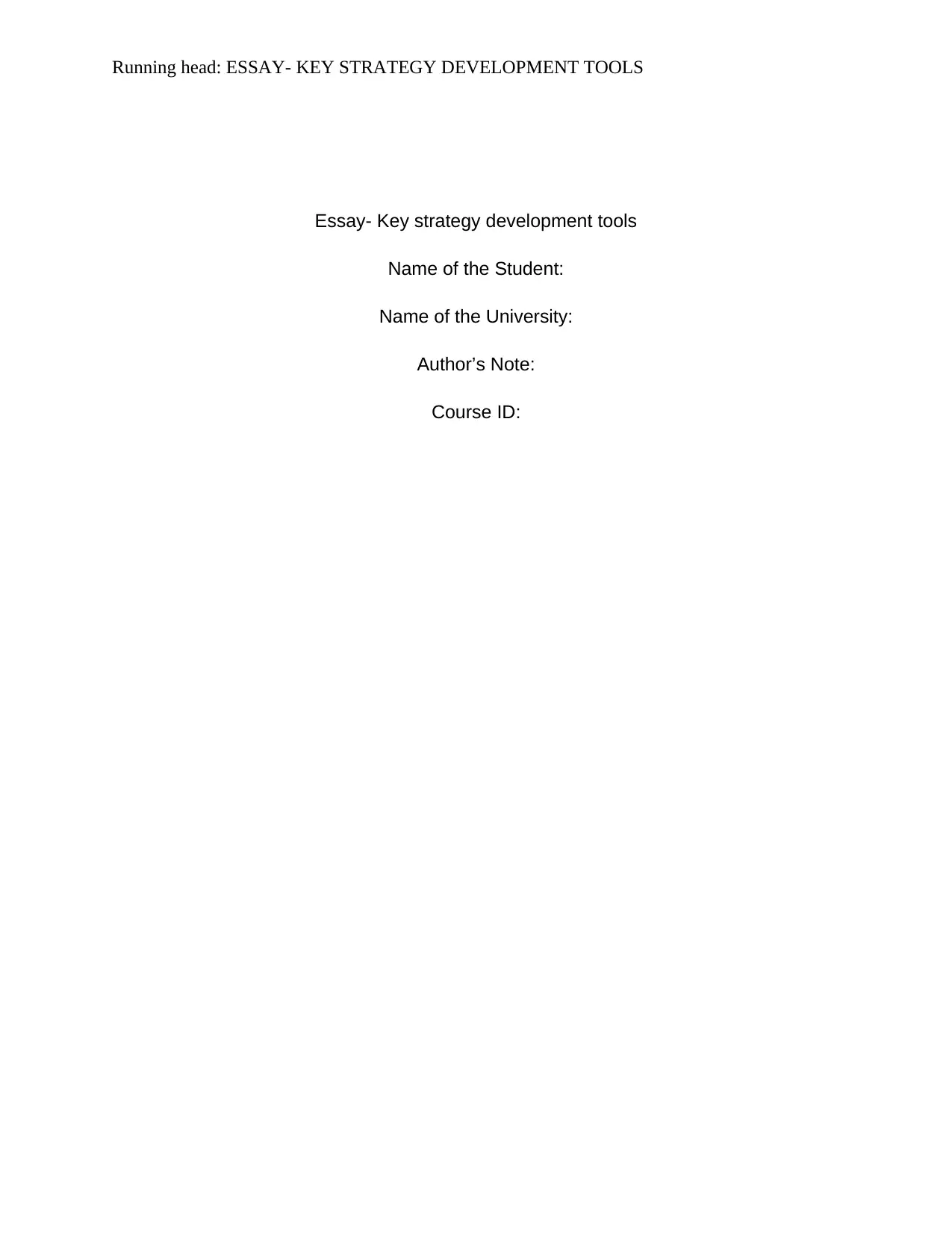
Running head: ESSAY- KEY STRATEGY DEVELOPMENT TOOLS
Essay- Key strategy development tools
Name of the Student:
Name of the University:
Author’s Note:
Course ID:
Essay- Key strategy development tools
Name of the Student:
Name of the University:
Author’s Note:
Course ID:
Paraphrase This Document
Need a fresh take? Get an instant paraphrase of this document with our AI Paraphraser
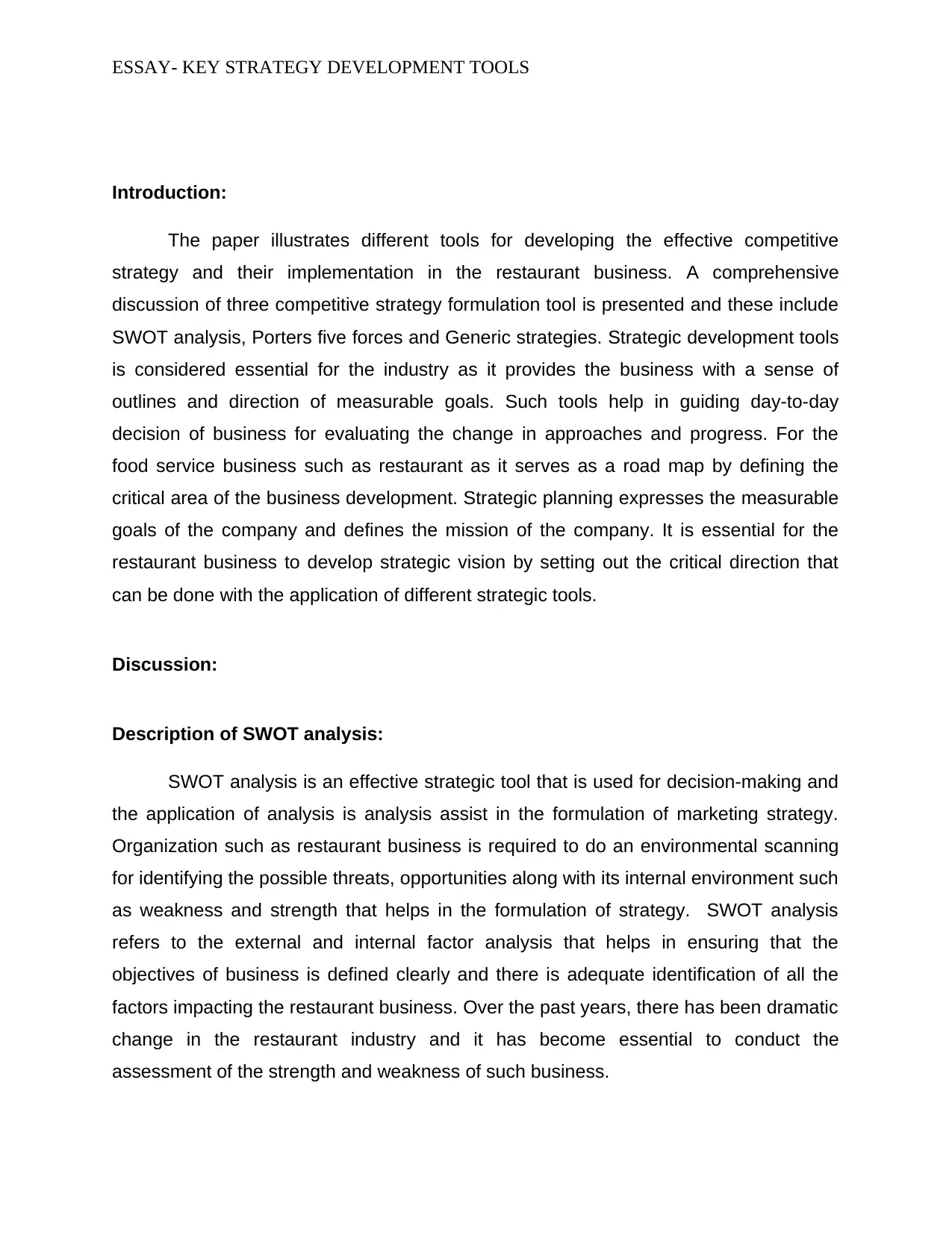
ESSAY- KEY STRATEGY DEVELOPMENT TOOLS
Introduction:
The paper illustrates different tools for developing the effective competitive
strategy and their implementation in the restaurant business. A comprehensive
discussion of three competitive strategy formulation tool is presented and these include
SWOT analysis, Porters five forces and Generic strategies. Strategic development tools
is considered essential for the industry as it provides the business with a sense of
outlines and direction of measurable goals. Such tools help in guiding day-to-day
decision of business for evaluating the change in approaches and progress. For the
food service business such as restaurant as it serves as a road map by defining the
critical area of the business development. Strategic planning expresses the measurable
goals of the company and defines the mission of the company. It is essential for the
restaurant business to develop strategic vision by setting out the critical direction that
can be done with the application of different strategic tools.
Discussion:
Description of SWOT analysis:
SWOT analysis is an effective strategic tool that is used for decision-making and
the application of analysis is analysis assist in the formulation of marketing strategy.
Organization such as restaurant business is required to do an environmental scanning
for identifying the possible threats, opportunities along with its internal environment such
as weakness and strength that helps in the formulation of strategy. SWOT analysis
refers to the external and internal factor analysis that helps in ensuring that the
objectives of business is defined clearly and there is adequate identification of all the
factors impacting the restaurant business. Over the past years, there has been dramatic
change in the restaurant industry and it has become essential to conduct the
assessment of the strength and weakness of such business.
Introduction:
The paper illustrates different tools for developing the effective competitive
strategy and their implementation in the restaurant business. A comprehensive
discussion of three competitive strategy formulation tool is presented and these include
SWOT analysis, Porters five forces and Generic strategies. Strategic development tools
is considered essential for the industry as it provides the business with a sense of
outlines and direction of measurable goals. Such tools help in guiding day-to-day
decision of business for evaluating the change in approaches and progress. For the
food service business such as restaurant as it serves as a road map by defining the
critical area of the business development. Strategic planning expresses the measurable
goals of the company and defines the mission of the company. It is essential for the
restaurant business to develop strategic vision by setting out the critical direction that
can be done with the application of different strategic tools.
Discussion:
Description of SWOT analysis:
SWOT analysis is an effective strategic tool that is used for decision-making and
the application of analysis is analysis assist in the formulation of marketing strategy.
Organization such as restaurant business is required to do an environmental scanning
for identifying the possible threats, opportunities along with its internal environment such
as weakness and strength that helps in the formulation of strategy. SWOT analysis
refers to the external and internal factor analysis that helps in ensuring that the
objectives of business is defined clearly and there is adequate identification of all the
factors impacting the restaurant business. Over the past years, there has been dramatic
change in the restaurant industry and it has become essential to conduct the
assessment of the strength and weakness of such business.
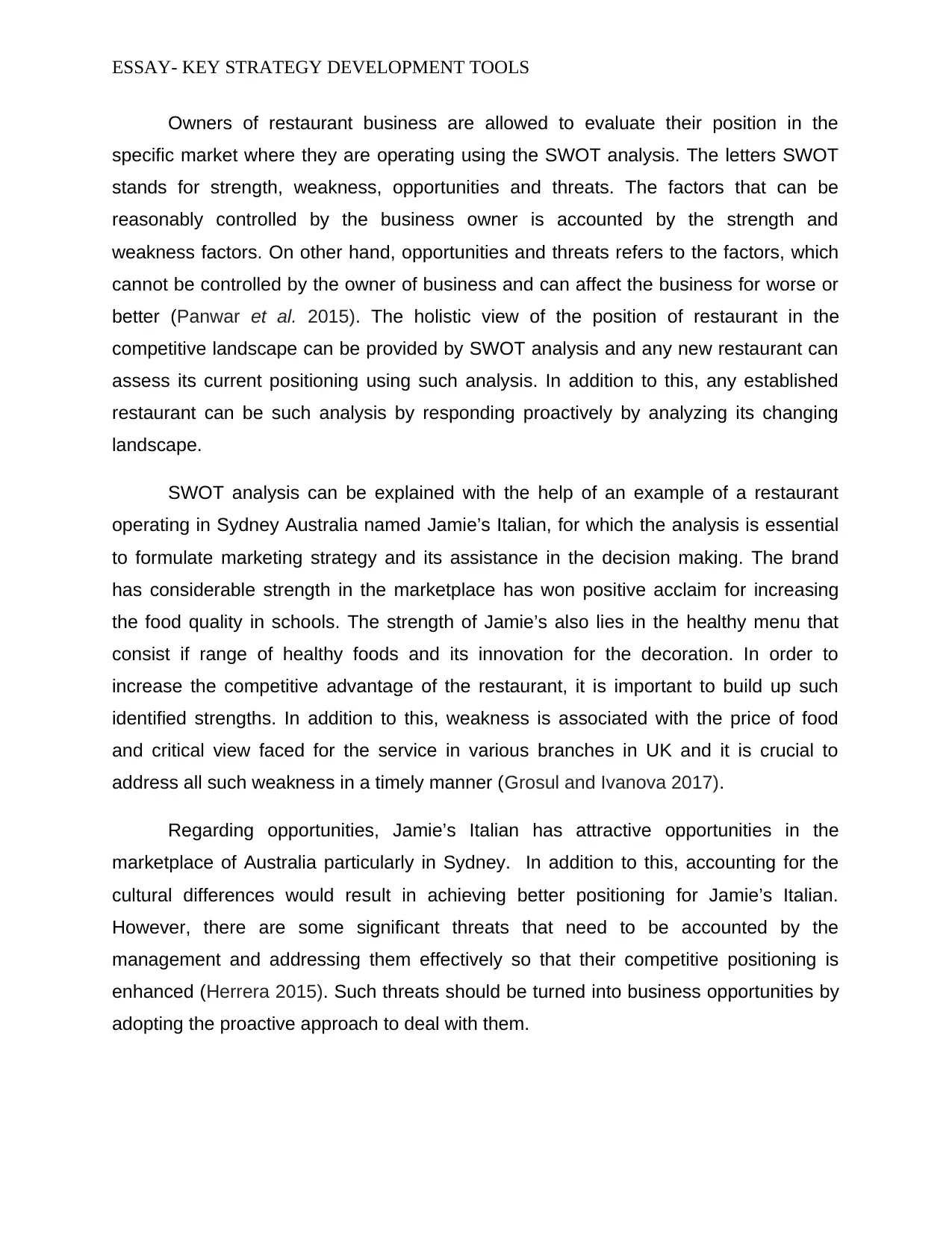
ESSAY- KEY STRATEGY DEVELOPMENT TOOLS
Owners of restaurant business are allowed to evaluate their position in the
specific market where they are operating using the SWOT analysis. The letters SWOT
stands for strength, weakness, opportunities and threats. The factors that can be
reasonably controlled by the business owner is accounted by the strength and
weakness factors. On other hand, opportunities and threats refers to the factors, which
cannot be controlled by the owner of business and can affect the business for worse or
better (Panwar et al. 2015). The holistic view of the position of restaurant in the
competitive landscape can be provided by SWOT analysis and any new restaurant can
assess its current positioning using such analysis. In addition to this, any established
restaurant can be such analysis by responding proactively by analyzing its changing
landscape.
SWOT analysis can be explained with the help of an example of a restaurant
operating in Sydney Australia named Jamie’s Italian, for which the analysis is essential
to formulate marketing strategy and its assistance in the decision making. The brand
has considerable strength in the marketplace has won positive acclaim for increasing
the food quality in schools. The strength of Jamie’s also lies in the healthy menu that
consist if range of healthy foods and its innovation for the decoration. In order to
increase the competitive advantage of the restaurant, it is important to build up such
identified strengths. In addition to this, weakness is associated with the price of food
and critical view faced for the service in various branches in UK and it is crucial to
address all such weakness in a timely manner (Grosul and Ivanova 2017).
Regarding opportunities, Jamie’s Italian has attractive opportunities in the
marketplace of Australia particularly in Sydney. In addition to this, accounting for the
cultural differences would result in achieving better positioning for Jamie’s Italian.
However, there are some significant threats that need to be accounted by the
management and addressing them effectively so that their competitive positioning is
enhanced (Herrera 2015). Such threats should be turned into business opportunities by
adopting the proactive approach to deal with them.
Owners of restaurant business are allowed to evaluate their position in the
specific market where they are operating using the SWOT analysis. The letters SWOT
stands for strength, weakness, opportunities and threats. The factors that can be
reasonably controlled by the business owner is accounted by the strength and
weakness factors. On other hand, opportunities and threats refers to the factors, which
cannot be controlled by the owner of business and can affect the business for worse or
better (Panwar et al. 2015). The holistic view of the position of restaurant in the
competitive landscape can be provided by SWOT analysis and any new restaurant can
assess its current positioning using such analysis. In addition to this, any established
restaurant can be such analysis by responding proactively by analyzing its changing
landscape.
SWOT analysis can be explained with the help of an example of a restaurant
operating in Sydney Australia named Jamie’s Italian, for which the analysis is essential
to formulate marketing strategy and its assistance in the decision making. The brand
has considerable strength in the marketplace has won positive acclaim for increasing
the food quality in schools. The strength of Jamie’s also lies in the healthy menu that
consist if range of healthy foods and its innovation for the decoration. In order to
increase the competitive advantage of the restaurant, it is important to build up such
identified strengths. In addition to this, weakness is associated with the price of food
and critical view faced for the service in various branches in UK and it is crucial to
address all such weakness in a timely manner (Grosul and Ivanova 2017).
Regarding opportunities, Jamie’s Italian has attractive opportunities in the
marketplace of Australia particularly in Sydney. In addition to this, accounting for the
cultural differences would result in achieving better positioning for Jamie’s Italian.
However, there are some significant threats that need to be accounted by the
management and addressing them effectively so that their competitive positioning is
enhanced (Herrera 2015). Such threats should be turned into business opportunities by
adopting the proactive approach to deal with them.
⊘ This is a preview!⊘
Do you want full access?
Subscribe today to unlock all pages.

Trusted by 1+ million students worldwide
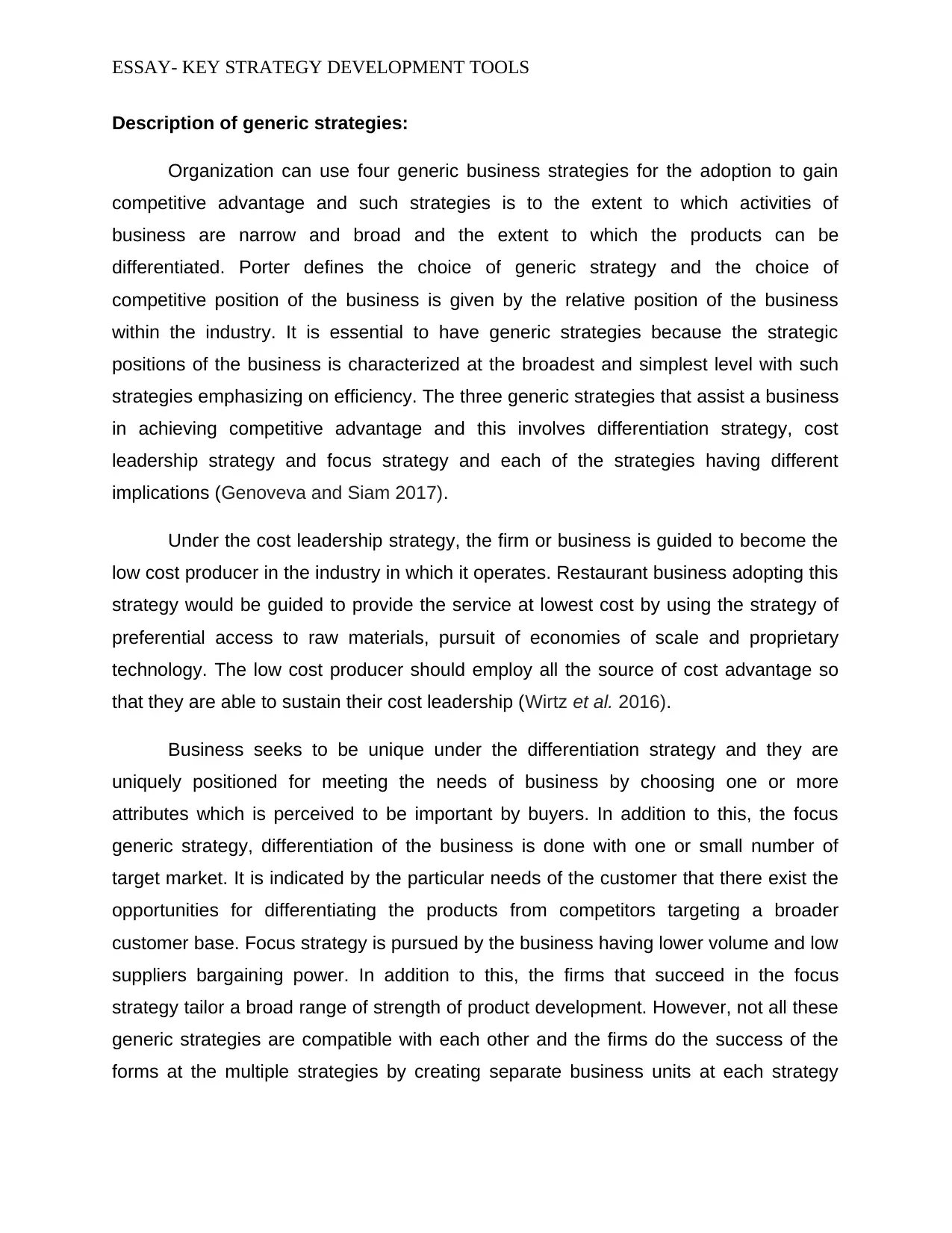
ESSAY- KEY STRATEGY DEVELOPMENT TOOLS
Description of generic strategies:
Organization can use four generic business strategies for the adoption to gain
competitive advantage and such strategies is to the extent to which activities of
business are narrow and broad and the extent to which the products can be
differentiated. Porter defines the choice of generic strategy and the choice of
competitive position of the business is given by the relative position of the business
within the industry. It is essential to have generic strategies because the strategic
positions of the business is characterized at the broadest and simplest level with such
strategies emphasizing on efficiency. The three generic strategies that assist a business
in achieving competitive advantage and this involves differentiation strategy, cost
leadership strategy and focus strategy and each of the strategies having different
implications (Genoveva and Siam 2017).
Under the cost leadership strategy, the firm or business is guided to become the
low cost producer in the industry in which it operates. Restaurant business adopting this
strategy would be guided to provide the service at lowest cost by using the strategy of
preferential access to raw materials, pursuit of economies of scale and proprietary
technology. The low cost producer should employ all the source of cost advantage so
that they are able to sustain their cost leadership (Wirtz et al. 2016).
Business seeks to be unique under the differentiation strategy and they are
uniquely positioned for meeting the needs of business by choosing one or more
attributes which is perceived to be important by buyers. In addition to this, the focus
generic strategy, differentiation of the business is done with one or small number of
target market. It is indicated by the particular needs of the customer that there exist the
opportunities for differentiating the products from competitors targeting a broader
customer base. Focus strategy is pursued by the business having lower volume and low
suppliers bargaining power. In addition to this, the firms that succeed in the focus
strategy tailor a broad range of strength of product development. However, not all these
generic strategies are compatible with each other and the firms do the success of the
forms at the multiple strategies by creating separate business units at each strategy
Description of generic strategies:
Organization can use four generic business strategies for the adoption to gain
competitive advantage and such strategies is to the extent to which activities of
business are narrow and broad and the extent to which the products can be
differentiated. Porter defines the choice of generic strategy and the choice of
competitive position of the business is given by the relative position of the business
within the industry. It is essential to have generic strategies because the strategic
positions of the business is characterized at the broadest and simplest level with such
strategies emphasizing on efficiency. The three generic strategies that assist a business
in achieving competitive advantage and this involves differentiation strategy, cost
leadership strategy and focus strategy and each of the strategies having different
implications (Genoveva and Siam 2017).
Under the cost leadership strategy, the firm or business is guided to become the
low cost producer in the industry in which it operates. Restaurant business adopting this
strategy would be guided to provide the service at lowest cost by using the strategy of
preferential access to raw materials, pursuit of economies of scale and proprietary
technology. The low cost producer should employ all the source of cost advantage so
that they are able to sustain their cost leadership (Wirtz et al. 2016).
Business seeks to be unique under the differentiation strategy and they are
uniquely positioned for meeting the needs of business by choosing one or more
attributes which is perceived to be important by buyers. In addition to this, the focus
generic strategy, differentiation of the business is done with one or small number of
target market. It is indicated by the particular needs of the customer that there exist the
opportunities for differentiating the products from competitors targeting a broader
customer base. Focus strategy is pursued by the business having lower volume and low
suppliers bargaining power. In addition to this, the firms that succeed in the focus
strategy tailor a broad range of strength of product development. However, not all these
generic strategies are compatible with each other and the firms do the success of the
forms at the multiple strategies by creating separate business units at each strategy
Paraphrase This Document
Need a fresh take? Get an instant paraphrase of this document with our AI Paraphraser
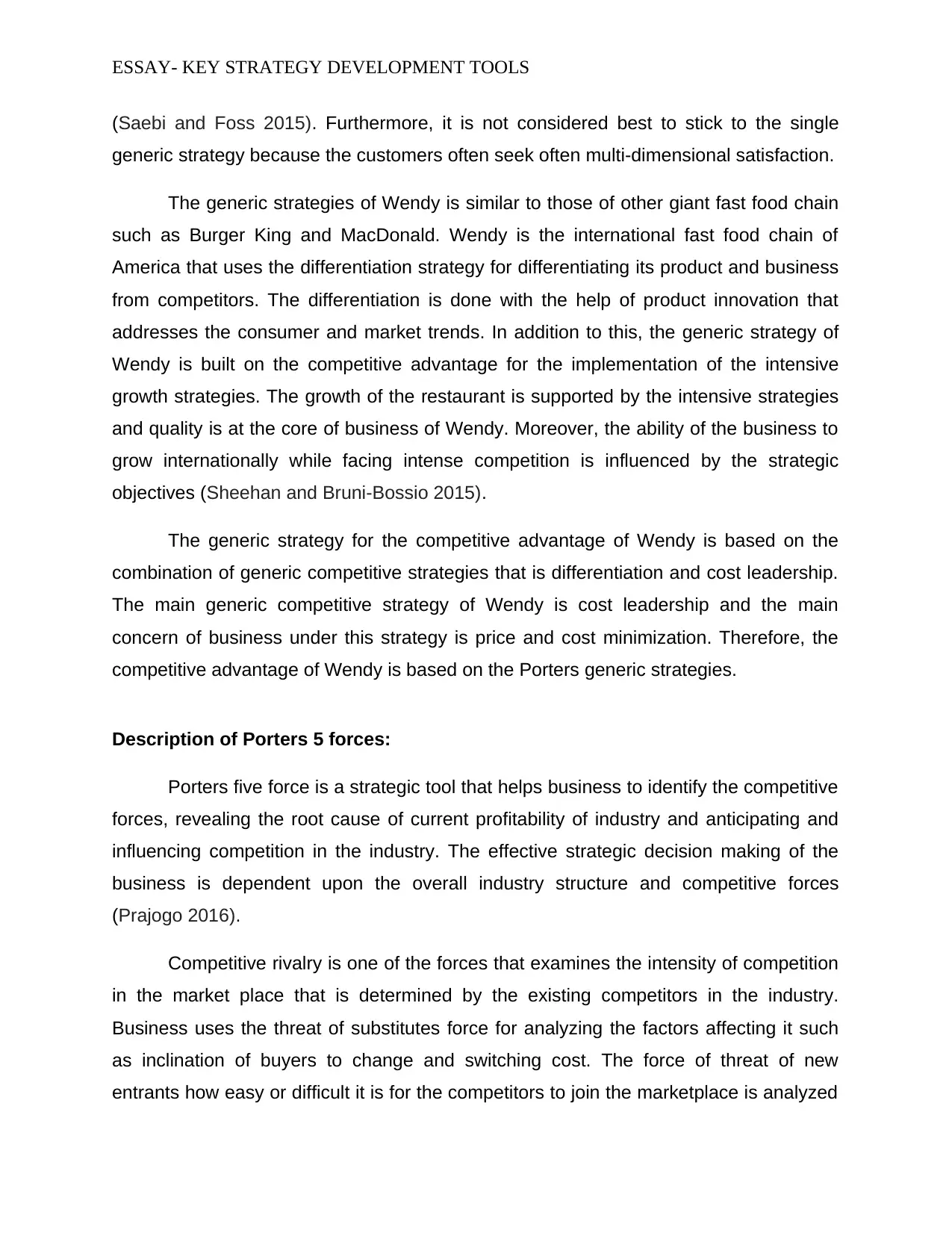
ESSAY- KEY STRATEGY DEVELOPMENT TOOLS
(Saebi and Foss 2015). Furthermore, it is not considered best to stick to the single
generic strategy because the customers often seek often multi-dimensional satisfaction.
The generic strategies of Wendy is similar to those of other giant fast food chain
such as Burger King and MacDonald. Wendy is the international fast food chain of
America that uses the differentiation strategy for differentiating its product and business
from competitors. The differentiation is done with the help of product innovation that
addresses the consumer and market trends. In addition to this, the generic strategy of
Wendy is built on the competitive advantage for the implementation of the intensive
growth strategies. The growth of the restaurant is supported by the intensive strategies
and quality is at the core of business of Wendy. Moreover, the ability of the business to
grow internationally while facing intense competition is influenced by the strategic
objectives (Sheehan and Bruni-Bossio 2015).
The generic strategy for the competitive advantage of Wendy is based on the
combination of generic competitive strategies that is differentiation and cost leadership.
The main generic competitive strategy of Wendy is cost leadership and the main
concern of business under this strategy is price and cost minimization. Therefore, the
competitive advantage of Wendy is based on the Porters generic strategies.
Description of Porters 5 forces:
Porters five force is a strategic tool that helps business to identify the competitive
forces, revealing the root cause of current profitability of industry and anticipating and
influencing competition in the industry. The effective strategic decision making of the
business is dependent upon the overall industry structure and competitive forces
(Prajogo 2016).
Competitive rivalry is one of the forces that examines the intensity of competition
in the market place that is determined by the existing competitors in the industry.
Business uses the threat of substitutes force for analyzing the factors affecting it such
as inclination of buyers to change and switching cost. The force of threat of new
entrants how easy or difficult it is for the competitors to join the marketplace is analyzed
(Saebi and Foss 2015). Furthermore, it is not considered best to stick to the single
generic strategy because the customers often seek often multi-dimensional satisfaction.
The generic strategies of Wendy is similar to those of other giant fast food chain
such as Burger King and MacDonald. Wendy is the international fast food chain of
America that uses the differentiation strategy for differentiating its product and business
from competitors. The differentiation is done with the help of product innovation that
addresses the consumer and market trends. In addition to this, the generic strategy of
Wendy is built on the competitive advantage for the implementation of the intensive
growth strategies. The growth of the restaurant is supported by the intensive strategies
and quality is at the core of business of Wendy. Moreover, the ability of the business to
grow internationally while facing intense competition is influenced by the strategic
objectives (Sheehan and Bruni-Bossio 2015).
The generic strategy for the competitive advantage of Wendy is based on the
combination of generic competitive strategies that is differentiation and cost leadership.
The main generic competitive strategy of Wendy is cost leadership and the main
concern of business under this strategy is price and cost minimization. Therefore, the
competitive advantage of Wendy is based on the Porters generic strategies.
Description of Porters 5 forces:
Porters five force is a strategic tool that helps business to identify the competitive
forces, revealing the root cause of current profitability of industry and anticipating and
influencing competition in the industry. The effective strategic decision making of the
business is dependent upon the overall industry structure and competitive forces
(Prajogo 2016).
Competitive rivalry is one of the forces that examines the intensity of competition
in the market place that is determined by the existing competitors in the industry.
Business uses the threat of substitutes force for analyzing the factors affecting it such
as inclination of buyers to change and switching cost. The force of threat of new
entrants how easy or difficult it is for the competitors to join the marketplace is analyzed
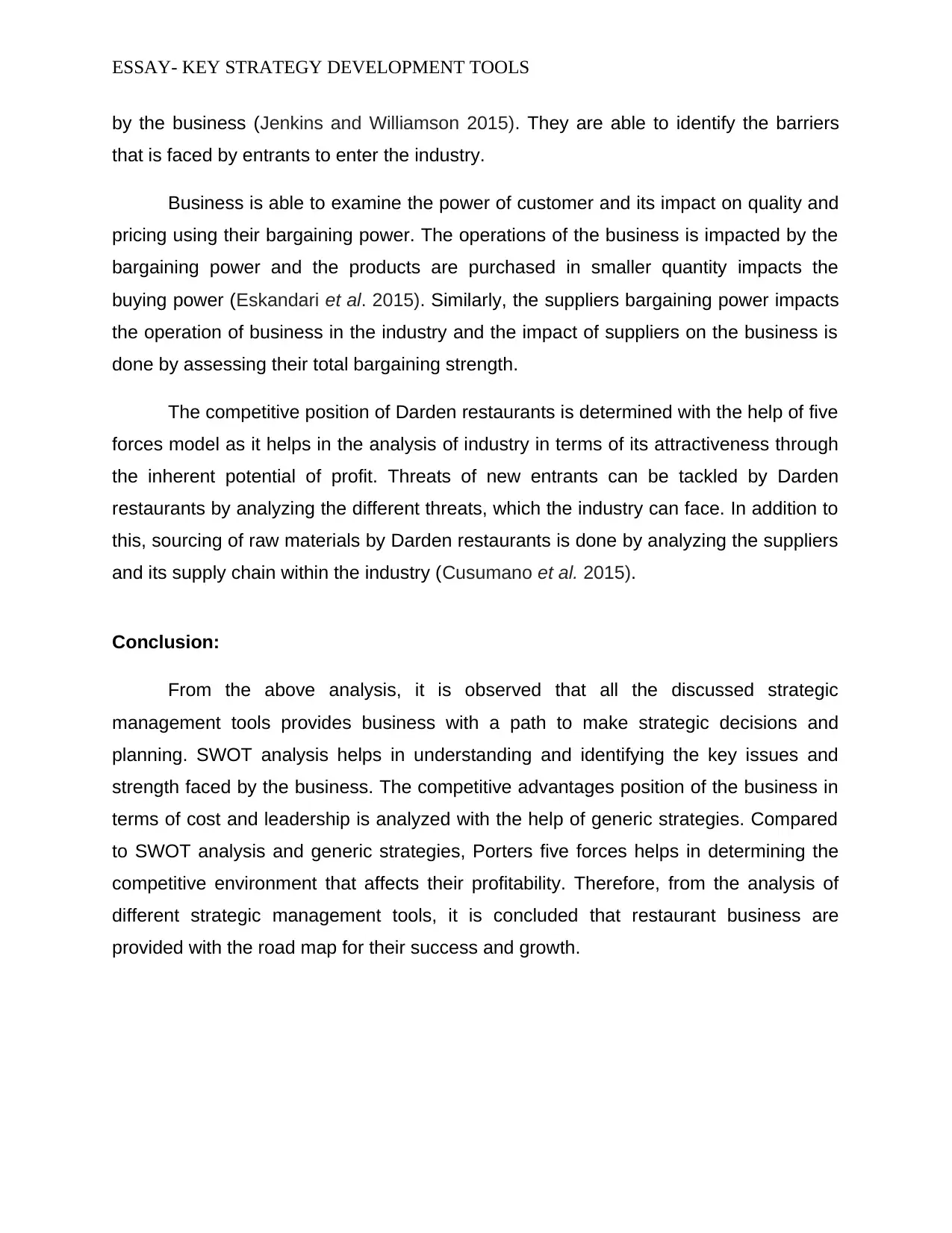
ESSAY- KEY STRATEGY DEVELOPMENT TOOLS
by the business (Jenkins and Williamson 2015). They are able to identify the barriers
that is faced by entrants to enter the industry.
Business is able to examine the power of customer and its impact on quality and
pricing using their bargaining power. The operations of the business is impacted by the
bargaining power and the products are purchased in smaller quantity impacts the
buying power (Eskandari et al. 2015). Similarly, the suppliers bargaining power impacts
the operation of business in the industry and the impact of suppliers on the business is
done by assessing their total bargaining strength.
The competitive position of Darden restaurants is determined with the help of five
forces model as it helps in the analysis of industry in terms of its attractiveness through
the inherent potential of profit. Threats of new entrants can be tackled by Darden
restaurants by analyzing the different threats, which the industry can face. In addition to
this, sourcing of raw materials by Darden restaurants is done by analyzing the suppliers
and its supply chain within the industry (Cusumano et al. 2015).
Conclusion:
From the above analysis, it is observed that all the discussed strategic
management tools provides business with a path to make strategic decisions and
planning. SWOT analysis helps in understanding and identifying the key issues and
strength faced by the business. The competitive advantages position of the business in
terms of cost and leadership is analyzed with the help of generic strategies. Compared
to SWOT analysis and generic strategies, Porters five forces helps in determining the
competitive environment that affects their profitability. Therefore, from the analysis of
different strategic management tools, it is concluded that restaurant business are
provided with the road map for their success and growth.
by the business (Jenkins and Williamson 2015). They are able to identify the barriers
that is faced by entrants to enter the industry.
Business is able to examine the power of customer and its impact on quality and
pricing using their bargaining power. The operations of the business is impacted by the
bargaining power and the products are purchased in smaller quantity impacts the
buying power (Eskandari et al. 2015). Similarly, the suppliers bargaining power impacts
the operation of business in the industry and the impact of suppliers on the business is
done by assessing their total bargaining strength.
The competitive position of Darden restaurants is determined with the help of five
forces model as it helps in the analysis of industry in terms of its attractiveness through
the inherent potential of profit. Threats of new entrants can be tackled by Darden
restaurants by analyzing the different threats, which the industry can face. In addition to
this, sourcing of raw materials by Darden restaurants is done by analyzing the suppliers
and its supply chain within the industry (Cusumano et al. 2015).
Conclusion:
From the above analysis, it is observed that all the discussed strategic
management tools provides business with a path to make strategic decisions and
planning. SWOT analysis helps in understanding and identifying the key issues and
strength faced by the business. The competitive advantages position of the business in
terms of cost and leadership is analyzed with the help of generic strategies. Compared
to SWOT analysis and generic strategies, Porters five forces helps in determining the
competitive environment that affects their profitability. Therefore, from the analysis of
different strategic management tools, it is concluded that restaurant business are
provided with the road map for their success and growth.
⊘ This is a preview!⊘
Do you want full access?
Subscribe today to unlock all pages.

Trusted by 1+ million students worldwide
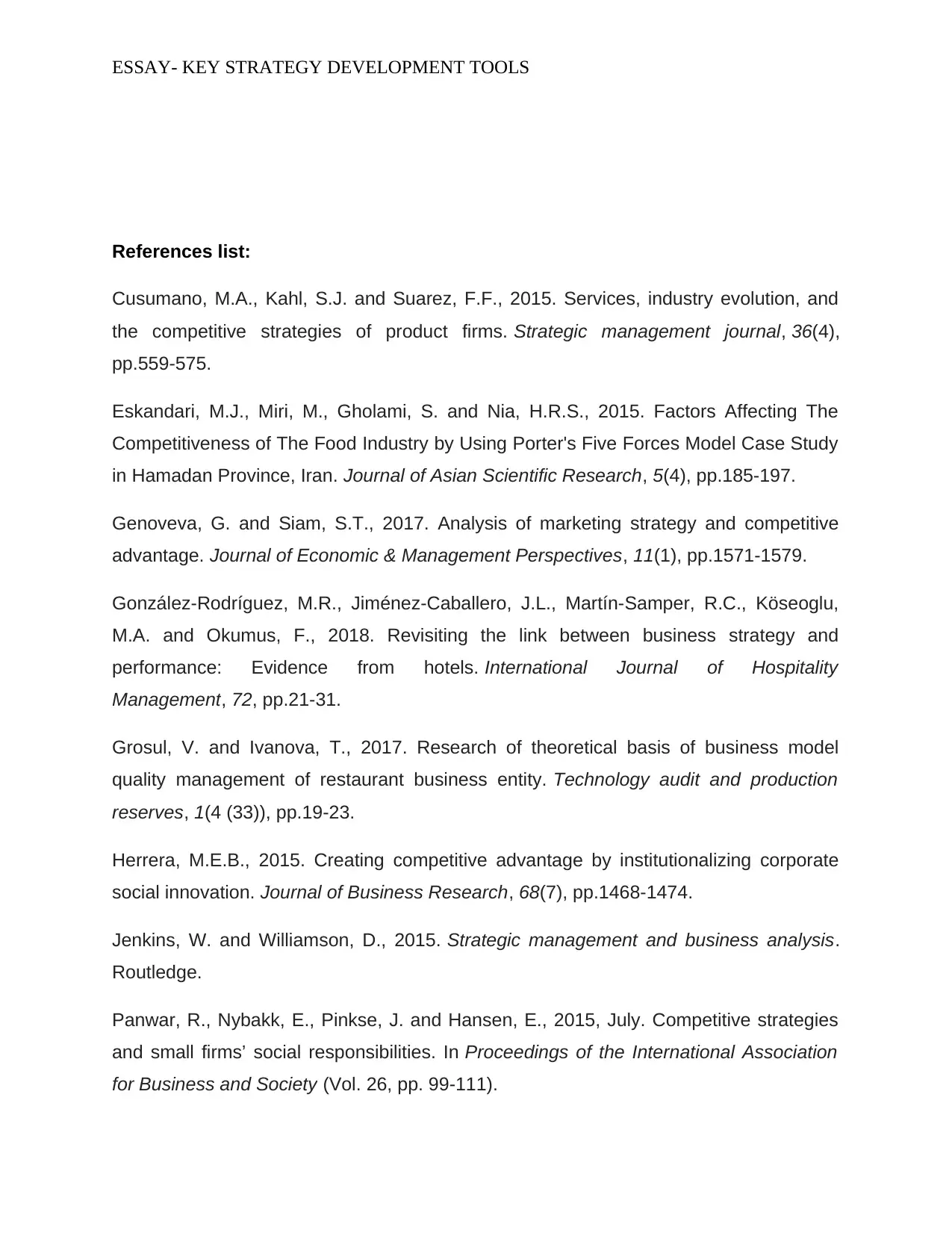
ESSAY- KEY STRATEGY DEVELOPMENT TOOLS
References list:
Cusumano, M.A., Kahl, S.J. and Suarez, F.F., 2015. Services, industry evolution, and
the competitive strategies of product firms. Strategic management journal, 36(4),
pp.559-575.
Eskandari, M.J., Miri, M., Gholami, S. and Nia, H.R.S., 2015. Factors Affecting The
Competitiveness of The Food Industry by Using Porter's Five Forces Model Case Study
in Hamadan Province, Iran. Journal of Asian Scientific Research, 5(4), pp.185-197.
Genoveva, G. and Siam, S.T., 2017. Analysis of marketing strategy and competitive
advantage. Journal of Economic & Management Perspectives, 11(1), pp.1571-1579.
González-Rodríguez, M.R., Jiménez-Caballero, J.L., Martín-Samper, R.C., Köseoglu,
M.A. and Okumus, F., 2018. Revisiting the link between business strategy and
performance: Evidence from hotels. International Journal of Hospitality
Management, 72, pp.21-31.
Grosul, V. and Ivanova, T., 2017. Research of theoretical basis of business model
quality management of restaurant business entity. Technology audit and production
reserves, 1(4 (33)), pp.19-23.
Herrera, M.E.B., 2015. Creating competitive advantage by institutionalizing corporate
social innovation. Journal of Business Research, 68(7), pp.1468-1474.
Jenkins, W. and Williamson, D., 2015. Strategic management and business analysis.
Routledge.
Panwar, R., Nybakk, E., Pinkse, J. and Hansen, E., 2015, July. Competitive strategies
and small firms’ social responsibilities. In Proceedings of the International Association
for Business and Society (Vol. 26, pp. 99-111).
References list:
Cusumano, M.A., Kahl, S.J. and Suarez, F.F., 2015. Services, industry evolution, and
the competitive strategies of product firms. Strategic management journal, 36(4),
pp.559-575.
Eskandari, M.J., Miri, M., Gholami, S. and Nia, H.R.S., 2015. Factors Affecting The
Competitiveness of The Food Industry by Using Porter's Five Forces Model Case Study
in Hamadan Province, Iran. Journal of Asian Scientific Research, 5(4), pp.185-197.
Genoveva, G. and Siam, S.T., 2017. Analysis of marketing strategy and competitive
advantage. Journal of Economic & Management Perspectives, 11(1), pp.1571-1579.
González-Rodríguez, M.R., Jiménez-Caballero, J.L., Martín-Samper, R.C., Köseoglu,
M.A. and Okumus, F., 2018. Revisiting the link between business strategy and
performance: Evidence from hotels. International Journal of Hospitality
Management, 72, pp.21-31.
Grosul, V. and Ivanova, T., 2017. Research of theoretical basis of business model
quality management of restaurant business entity. Technology audit and production
reserves, 1(4 (33)), pp.19-23.
Herrera, M.E.B., 2015. Creating competitive advantage by institutionalizing corporate
social innovation. Journal of Business Research, 68(7), pp.1468-1474.
Jenkins, W. and Williamson, D., 2015. Strategic management and business analysis.
Routledge.
Panwar, R., Nybakk, E., Pinkse, J. and Hansen, E., 2015, July. Competitive strategies
and small firms’ social responsibilities. In Proceedings of the International Association
for Business and Society (Vol. 26, pp. 99-111).
Paraphrase This Document
Need a fresh take? Get an instant paraphrase of this document with our AI Paraphraser
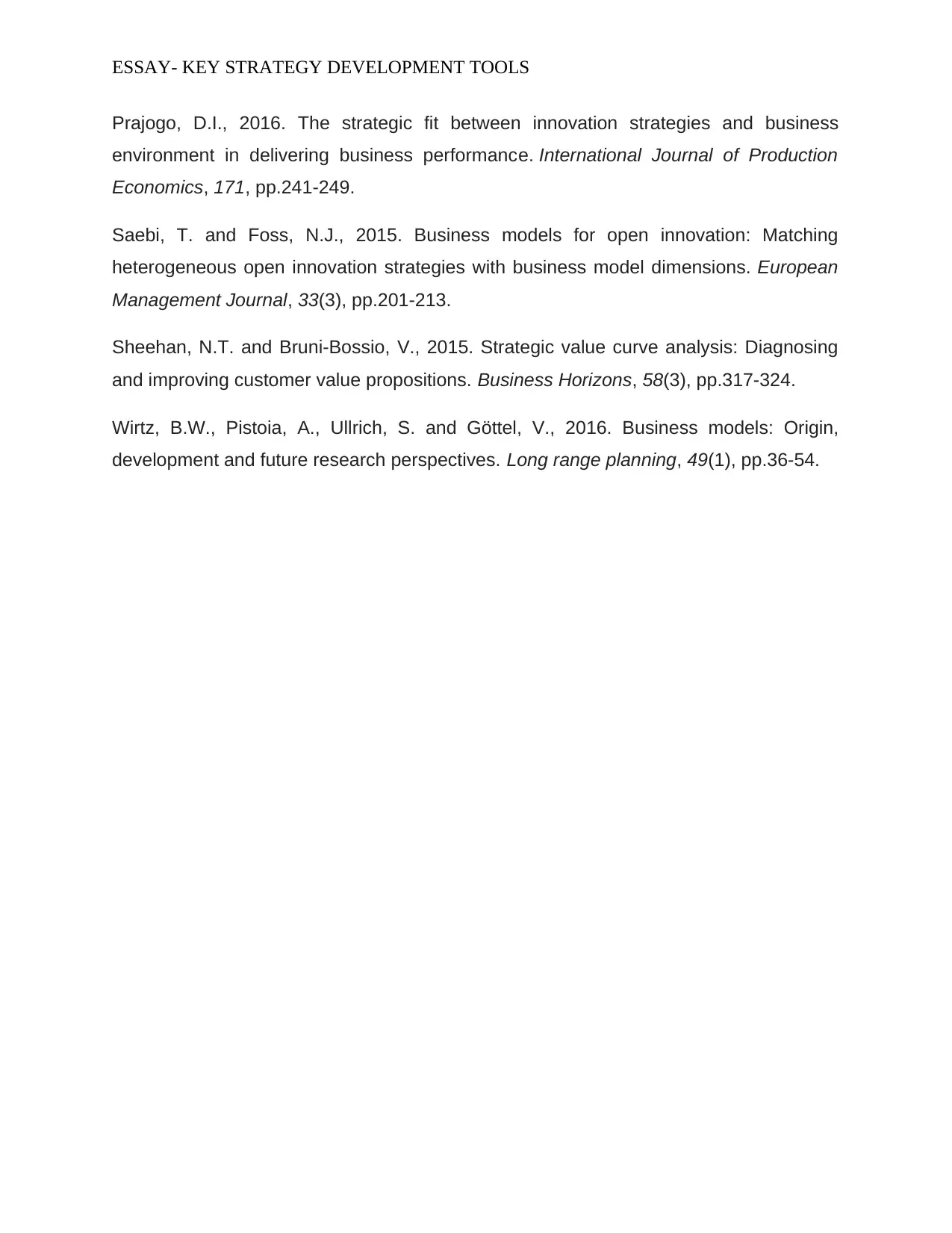
ESSAY- KEY STRATEGY DEVELOPMENT TOOLS
Prajogo, D.I., 2016. The strategic fit between innovation strategies and business
environment in delivering business performance. International Journal of Production
Economics, 171, pp.241-249.
Saebi, T. and Foss, N.J., 2015. Business models for open innovation: Matching
heterogeneous open innovation strategies with business model dimensions. European
Management Journal, 33(3), pp.201-213.
Sheehan, N.T. and Bruni-Bossio, V., 2015. Strategic value curve analysis: Diagnosing
and improving customer value propositions. Business Horizons, 58(3), pp.317-324.
Wirtz, B.W., Pistoia, A., Ullrich, S. and Göttel, V., 2016. Business models: Origin,
development and future research perspectives. Long range planning, 49(1), pp.36-54.
Prajogo, D.I., 2016. The strategic fit between innovation strategies and business
environment in delivering business performance. International Journal of Production
Economics, 171, pp.241-249.
Saebi, T. and Foss, N.J., 2015. Business models for open innovation: Matching
heterogeneous open innovation strategies with business model dimensions. European
Management Journal, 33(3), pp.201-213.
Sheehan, N.T. and Bruni-Bossio, V., 2015. Strategic value curve analysis: Diagnosing
and improving customer value propositions. Business Horizons, 58(3), pp.317-324.
Wirtz, B.W., Pistoia, A., Ullrich, S. and Göttel, V., 2016. Business models: Origin,
development and future research perspectives. Long range planning, 49(1), pp.36-54.
1 out of 8
Related Documents
Your All-in-One AI-Powered Toolkit for Academic Success.
+13062052269
info@desklib.com
Available 24*7 on WhatsApp / Email
![[object Object]](/_next/static/media/star-bottom.7253800d.svg)
Unlock your academic potential
Copyright © 2020–2025 A2Z Services. All Rights Reserved. Developed and managed by ZUCOL.




